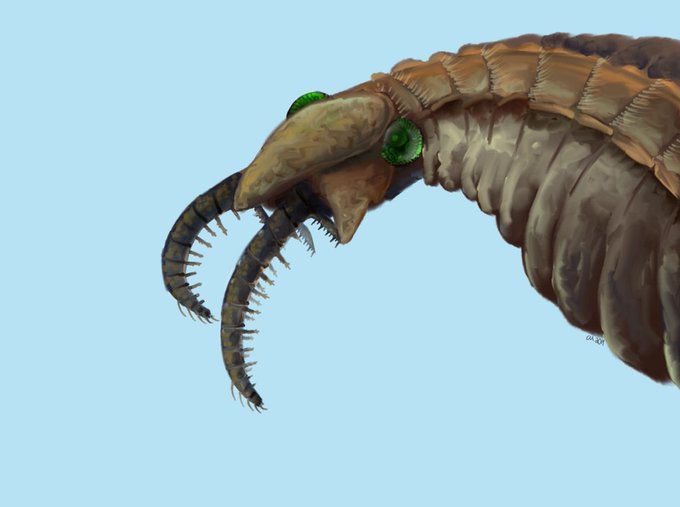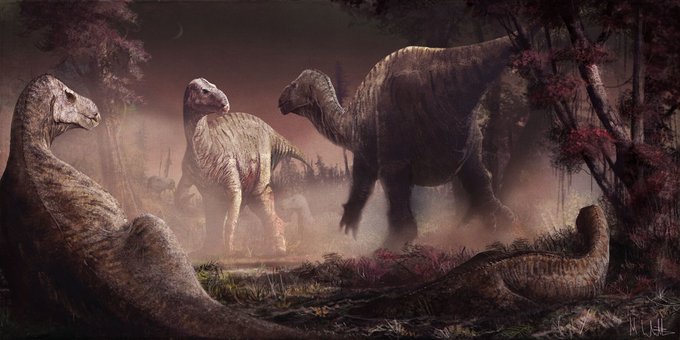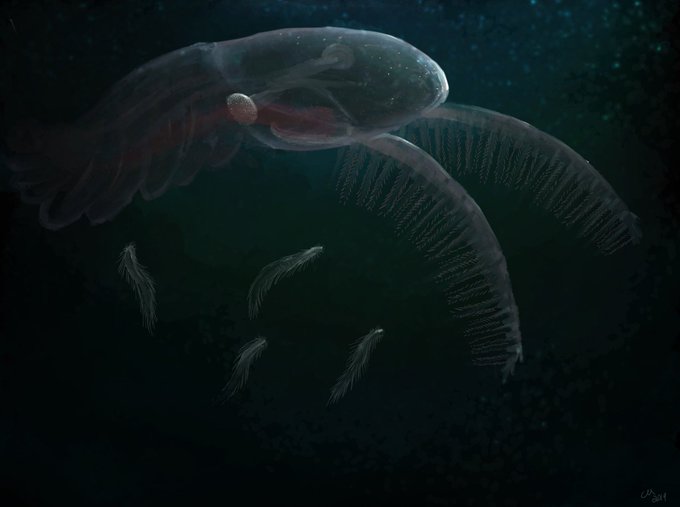palaeontologyのTwitterイラスト検索結果。 198 件中 8ページ目
Nice: "Patterns In Palaeontology: Digitally Peering Inside #Fossil Skulls" https://t.co/3VKSymAJHN
For my first post on this #FossilFriday, the fantastic appendages of Anomalocaris magnabasis! Unlike Anomalocaris canandensis, A. magnabasis had a bunch of thin “spinules” projecting from the front side of each spine, used to help snare soft prey.
#Palaeontology #Paleoart
A redraw of “Hurdia megamouth”, an as of yet undescribed species of Hurdiid currently being worked on. As my personal nickname for it suggests, it’s mouth was massive. Excited for the description.
#Paleoart #Palaeontology
Tritonychus was an aquatic, Onychophoran-branch Lobopodian that lived in the tropical sea of Cambrian China. It had three claws on each leg. The holotype of Tritonychus is exceptionally well preserved in 3D, usually something only possible in the Orsten
#Paleoart #Palaeontology
For fossil Friday, have a really cool fossil of Horn Coral. Embedded in the rock and largely crystallized. It’s a really neat little fossil, not for the animals in it, but for how they preserved. Devonian, Ontario.
#FossilFriday
#Palaeontology
Lastly, and undescribed, a Collins Monster, named after @ROMtoronto’s past Invertebrate palaeontology curator, Desmond Collins. It was the most derived of the Collins Monsters, being short and stout, and having only one large spine per segment.
Laminacaris chimera, a strange intersection between the Hurdiid Anomalocarids and the Amplectobeluids, inhabited the waters of the Chengjiang sea 518 million years ago. Described by @StephenPates, @cambriancritter, and their colleagues in 2018.
#Paleoart #Palaeontology #SciArt
For a first preview for "Palaeontology in Popular Culture" event at King's College London on 2 September. 18:00-20:15 (two weeks time!) - @MarkWitton will be exhibiting on "A Celebration of the Crystal Palace Dinosaurs."
Attendance free, sign up here: https://t.co/StVXywOBV2
Announcing “Palaeontology in Popular Culture” event on Monday 2 September, 18:00-20:15 at King’s College London, attached to the next #PopPalaeo workshop (in time for #FossilFriday!).
Attendance free. Sign up here if you want to come along: https://t.co/StVXywOBV2
Fabulous tour this morning of the library and archive @morethanadodo
Did you know we are the only @UniofOxford library that is fully accessible to the public?
#entomology #zoology #geology #palaeontology for all!
https://t.co/HjZhojsKY8
Thanahita, essentially meaning “water goddess”, was a very strange Lobopod. Instead of traditional sclerites running down the trunk (one per segment), it had weird shrub-shaped structures that ran down its back. It also had two kinds of claws.
#Paleoart #Palaeontology #SciArt
Meet Cambroraster, a new Hurdiid from the Marble Canyon region in close proximity to the Burgess Shale. This animal is... incredibly weird, even for a Hurdiid. It had a tiny body, a giant, spiked head shield, and very strange appendages.
#Paleoart #Palaeontology #SciArt
Take a look at this incredible duck-billed dinosaur, or ‘shovel-chinned eagle nose’, a new species of primitive hadrosaurid that lived 80 million years ago in Texas.
To read this popular article in full, visit: https://t.co/Zd8athILQJ #Palaeontology @JournalSystPal #scicomm
Some paleoart of Lacusovagus, an Azhdarchoid pterosaur described in 2008 by @MarkWitton. It lived in the Crato Formation. Follow @LikesPterosaurs if you like pterosaurs, they make some amazing skeletals.
#Paleoart #Palaeontology #SciArt
Tamisiocaris and Phragmochaeta in their natural habitat, about 900-1000 meters below the ocean surface. The only thing we know about Tamisiocaris is what their antennae looked like. All else is up to interpretation.
#Paleoart #Palaeontology #SciArt
Hope I’m not too late for #PortfolioDay. I’m Owen, I’m a palaeontology student and I really enjoy making concepts and concept art. @PlayWarframe is my current fascination. Currently working on developing my digital art skills and learning 3D modelling!
This handsome chap is the perfect welcome for todays symposium on #dinosaurs research, organised by @WillTattersdill at @Palaeo_Bham @LapworthMuseum. Interdisciplinary discussions on #palaeontology, teaching, #scicomm, #museums & more.
Oh no, it’s the Echinoderm takeover! Run, Schinderhannes!
#Paleoart #Palaeontology
Hi all,
Just a quick Troodontid #Dinodoodle.
Enjoy!
#paleoart #palaeontology #Troodon #dinosaur #feathers
Okay. You asked, I did it, even though it was hell to draw.
Acinocrinus stichus, “row of thorny rings”. This was a giant “Collins Monster” type Lobopodian, extremely tank animals. Acinocrinus took this to a new level.
#Paleoart #Palaeontology #SciArt
More to come soon.










































